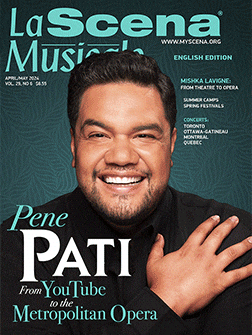
This page is also available in / Cette page est également disponible en:
![]() Francais (French)
Francais (French)
Kent Nagano has a soft spot in his heart for the province of Quebec. In conversation with La Scena Musicale, he talks about a place he views as a cultural point of reference. Considering his extensive experience as a conductor of some of the world’s finest symphony and opera house orchestras, he knows what he is talking about: his words are worth their weight in gold.
Despite having left his role as principal conductor of the OSM, Nagano pays occasional visits to the city. The next one scheduled for April 10-12, when he will take on two major orchestral works: Les noces by Stravinsky and Beethoven’s Eroica Symphony.
“In the ten-years since my recording of the Eroica for Analekta, I have performed the symphony a good 25 times,” says Nagano, “and in several countries, too: Austria, France, Germany and Italy. I really love how the OSM plays Beethoven — they approach the music in such a lively way, and make it sound really fresh and relevant to our time.”
Nagano’s assessment rests on the belief that the orchestra’s sophistication is connected to some degree to the culture and history of the land: “Quebec is one of the rare places on the continent that never severed its ties to Europe. More than one language is spoken here. I’ve had conversations not only in English or French, even Québécois, but German and Italian as well, almost on a daily basis. One should bear in mind that Beethoven was heard all over Europe during the Napoleonic Wars, and because of those ties I mentioned, I think there is a special affinity to his music here in Quebec. His works keep showing up on concert programs.”

Maison symphonique (Photo provided)
Beethoven originally intended to dedicate this third symphony he who was viewed in his time as a hero of the French Revolution, having liberated the French people from the monarchy. When he found out that Napoleon’s army invaded his German homeland, however, the composer famously crossed out that name on the cover page of his manuscript. Two centuries later, the work still echoes this political history, and the heroism displayed in the face of adversity. This begs the question of whether there are parallels between that chapter in history, and the current events in Eastern Europe, where a dictator is currently doing the same to a neighboring country. Nagano contends that one cannot divorce the work from today’s context, when so many people are acutely aware of the instability and strife reigning in the world,. He contends that that reality weighs in the balance to some degree, more on an abstract level, but still there.
Nagano’s previous Montreal appearance was only four months ago, when he led the OSM during a reading of a Christmas tale by storyteller Fred Pellerin. “He’s Québécois through and through,” says the conductor, “he’s very creative and sophisticated, which makes him a true artist, at once stimulating and inspiring to work with. It is the Québécois spirit in him that I find rewarding, that tradition of delving into topics bristling in humanity, coloured by a touch of irony that make them universally understood regardless of their origins. The experience is all the more special given the intimacy of the venue, the Maison symphonique.”
Maestro Nagano goes on to talk about some of his more recent experiences, notably his work as musical director of the Hamburg State Opera, and as principal of its symphony orchestra, which brings regularly at the famed Elbphilharmonie. He was on hand in 2017 at the inauguration of that concert hall of extraordinary acoustics built within an architecturally stunning structure. During his Montreal tenure he was very much involved in the process leading to the construction of the Maison symphonique. Asked about that, he notes that “you can never be sure in advance if a hall will live up to all expectations. There is always some mystery between theoretical considerations of design and acoustics and actual results. But if I may so say, the citizens of Quebec ought to be very proud of the venue. Its reputation on the international scene is established. I always feel privileged to be present when a community, like the one here, decides to advance the cause of culture. A concert hall is more than just a place to see music live: people gathered there in days past to socialize, entertain and simply share experiences on events presented within its walls. Under such circumstances, concert halls are crucibles where the mores of society are put on display and validated. I was really moved on one occasion when someone came off the street to attend a concert and said to me: ̔It’s amazing to hear my orchestra.’ That tells me that the OSM is a means of identification for society–a mirror of sorts–that people can peer into, which is what the Maison symphonique ought to be: a looking glass for a community to view the world through, and vis-versa. Concert experiences allow us to grow when we engage on this two-way street, so it makes perfect sense that the Maison symphonique welcomes orchestras from around the world.”
Kent Nagano will continue to conduct the historically informed concertante performances of Wagner’s Ring over the next years. This project is called “The Wagner Cycles” and is a project of the Dresden Music Festival and its Director Jan Vogler who is also artistic director together with Kent Nagano for “The Wagner Cycles”. Performances of the “Walküre” with the Dresdner Festspielorchester together with Concerto Köln will take place on May 1 in Elbphilharmonie Hamburg, at the Dresden Music Festival on May 9 and at the Lucerne Festival on August 21.
Translation by Marc Chénard
Orchestre symphonique de Montréal
www.osm.ca
Playlist
This page is also available in / Cette page est également disponible en:
![]() Francais (French)
Francais (French)















